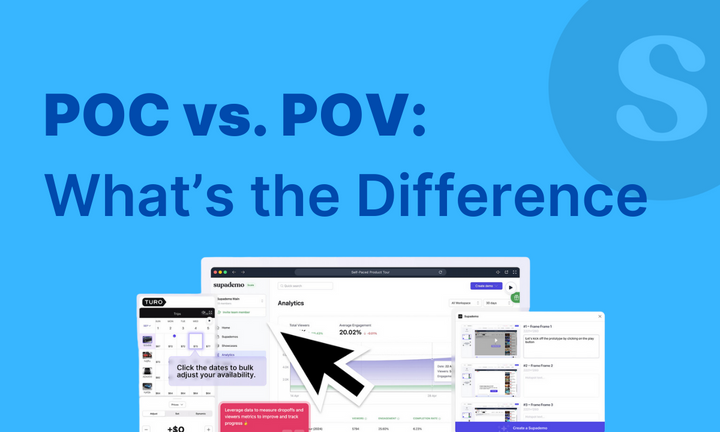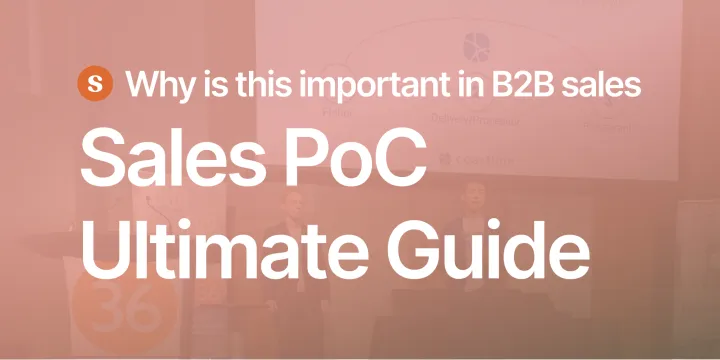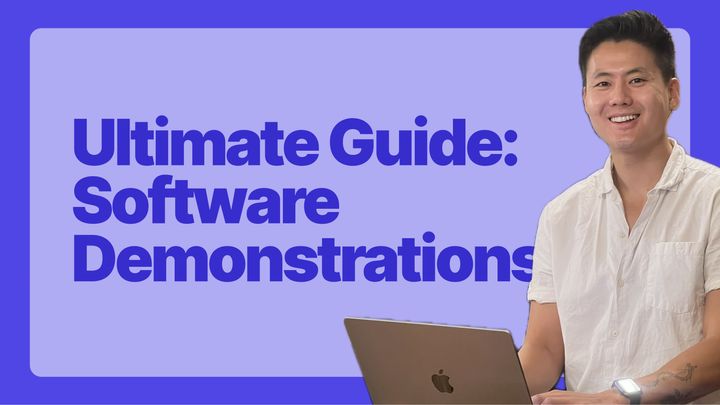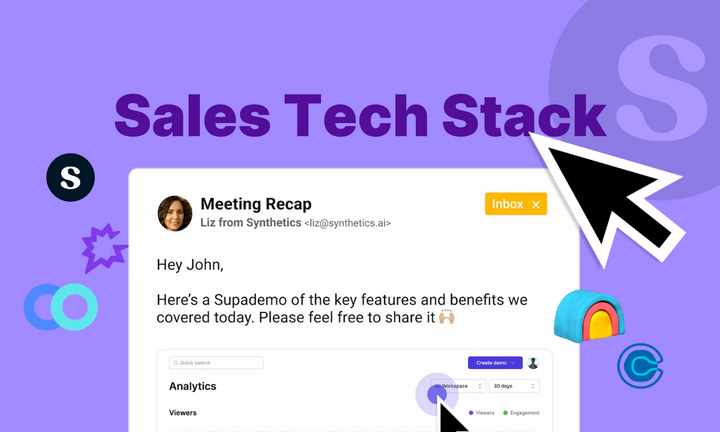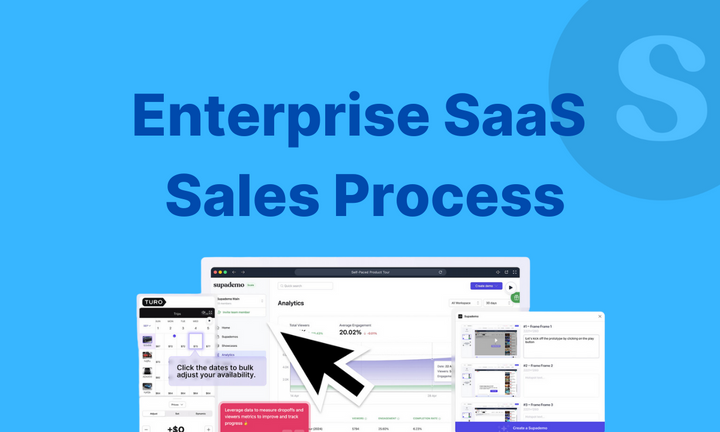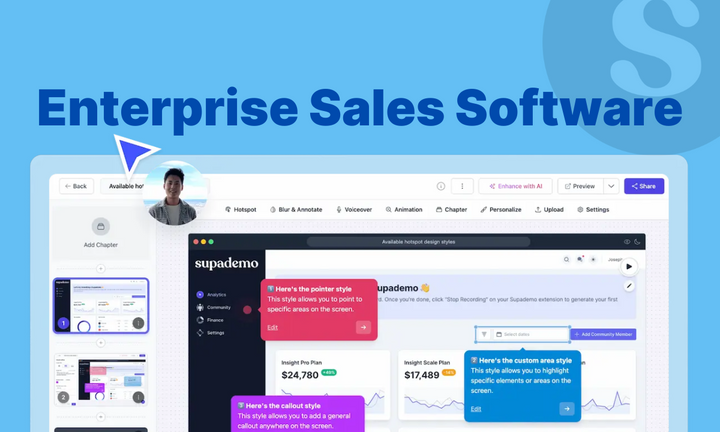Enterprise sales can feel like a marathon of meetings, stakeholders, and stalled decisions. And when teams confuse a Proof of Concept (POC) with a Proof of Value (POV)? That marathon turns into a maze.
Both are critical but for very different reasons. A POC answers, “Can this work here?” while a POV asks, “Will this be worth it?” Mix them up, and you’ll either bore the CFO with tech specs or frustrate engineers with ROI models.
In this guide, we’ll break down the core differences between POC vs POV, show you when (and how) to use each, and share best practices to close enterprise deals with clarity and confidence.
POC vs POV: Key differences at a glance
| Aspect | POC | POV |
|---|---|---|
| Goal | Technical validation | Business validation |
| Deliverables | Sandbox environment, prototype, test runs | ROI models, executive summaries, value briefs |
| Audience | Engineers, IT, security | CFO, procurement, business leaders |
| Success metric | Technical pass/fail | Projected or proven business value |
| Sales stage | Mid-funnel | Late-funnel |
When evaluating enterprise software, Proof of Concept (POC) and Proof of Value (POV) are two pivotal validation tools, but they serve very different purposes. To move deals forward efficiently and align cross-functional teams, it’s crucial to know exactly when to use each, who they’re for, and what outcomes to expect.
Let’s break it down across five key areas:
Purpose and objective
POC is all about feasibility. It asks, “Can this product technically work within our environment?” Teams use it to de-risk implementation, confirm compatibility, and test performance. Think of it like a sandbox where engineering gets to play.
By contrast, POV focuses on value realization. It answers, “Will this investment move the needle for our business?” That means tying features to measurable ROI, increased efficiency, or cost savings. While a POC might be a pass/fail test for integrations, a POV is closer to a business case pitch, complete with financial projections.
Primary audience
This distinction shapes who drives the process.
POC: IT teams, engineers, and security folks, those who’ll live with the tech day-to-day.
POV: Executive sponsors, procurement heads, finance teams—people signing the checks.
Focus and outcome
The lens of success is different depending on whether you’re running a POC or POV.
- POC: The focus is squarely on functionality. Can the product do what it claims? Does it integrate with our tools? Are there performance issues at scale? The outcome here is technical validation; it either works or it doesn’t.
- POV: Here, the conversation shifts to value. What is the tangible benefit? Can it shorten sales cycles? Improve lead conversion? Boost internal efficiency? A successful POV proves that the product is worth the investment.
Timing in the sales cycle
When these evaluations happen is just as important as how they happen.
- POCs are mid-funnel activities. They typically follow early-stage qualification and discovery calls but precede commercial negotiations. If a deal is stalling because of IT concerns or integration questions, the POC acts as a bridge to keep momentum going.
- POVs show up late-funnel, often after internal champions have already been bought in but still need to justify the spending. This is where ROI calculators, impact forecasts, and internal selling decks come into play. A POV gives stakeholders the ammunition they need to secure budget approval and executive alignment.
Think of it as a relay race: the POC hands off the baton to the POV. One clears technical blockers; the other unlocks economic buy-in.
Typical deliverables
What is produced during each phase can vary widely, and this affects not just sales outcomes but also how buyers experience your product.
POC deliverables are technical. These include:
- Sandbox environments or isolated instances of the product.
- API tests or limited integrations.
- Feature-specific walkthroughs.
- Performance benchmarks or logs.
These assets give technical users a safe space to tinker and confirm feasibility.
POV deliverables are business-facing. They typically include:
- ROI models tailored to the customer’s KPIs
- Executive-ready summaries or visual dashboards
- Value analysis frameworks comparing cost vs. benefit
- Use-case specific demo experiences
When to use a POC vs a POV
Understanding the right moment to introduce a Proof of Concept POC or POV can help move deals forward faster, with less friction from internal stakeholders. Here’s how to identify the ideal scenarios for each:
Scenarios for POC
Use a POC when technical feasibility is still in question. This is particularly common when you're introducing something new or unproven.
Let’s say you’re selling a platform with complex APIs to a fintech company. If their engineers are unsure about integration with legacy systems or regulatory compliance requirements, jumping into ROI discussions is premature. You need a POC to clear the technical fog.
Another green light for a POC? When technical stakeholders are blockers. If the CTO or IT lead hasn’t bought in, the rest of the conversation won’t matter. A sandbox environment or lightweight integration test can remove these barriers early, before you lose momentum.
For example, At Spare Labs, a mobility operations platform managing over 20 million rides globally, demo creation was a massive time sink. Their solutions engineering team previously spent 2 hours per demo video building enablement demos with tools like Loom.
By switching to Supademo, they created custom interactive demos at scale, cutting over 50 hours per month across their presales org. The result? Technical alignment with less manual effort, setting the stage for a business conversation.
Scenarios for POV
Once technical confidence is established, or the product is inherently easy to implement, it’s time to move to a POV. This is especially useful when the customer is sold on the product but needs internal buy-in from finance or procurement.
Here, the POV acts as a bridge to the C-suite, answering the questions that matter most to execs: Will this make or save money? Will it justify the budget allocation?
If you're in a competitive deal or quoting a high-cost solution, a POV can tilt the decision in your favor by showcasing projected ROI or time-to-value.
Can you use both POC and POV?
While POC and POV are often framed as separate paths, many successful enterprise sales teams use both, either sequentially or in a blended approach to build confidence across technical and business stakeholders. Let’s break down how that works:
Sequential approach
The most common route: start with a POC to eliminate technical concerns, then follow it with a POV to close the deal.
For instance, a sales engineer might run a lightweight integration test to show compatibility with a client’s CRM stack. Once that hurdle is cleared, the account executive rolls out a POV demo that highlights the revenue gains, time saved, or reduced churn potential.
Standalone POVs
When your product is intuitive, easy to deploy, or built on a familiar stack, technical validation becomes a low priority. Here, a POV alone can carry the deal by focusing entirely on measurable outcomes.
This scenario is especially common in SaaS environments where setup takes minutes, not weeks, and where time-to-value is immediately demonstrable.
Integrated approach
Some teams prefer to combine both goals in a single trial, especially in high-velocity sales environments.
An integrated POV+POC approach is especially powerful when you're dealing with tight timelines, multiple stakeholders, or enterprise accounts with cross-functional buying committees. It meets everyone where they are, without needing to run separate playbooks.
See this in action through our Mixpanel sandbox demo that combines feasibility and business value in one seamless flow.
What is a Proof of Concept (POC)?
A Proof of Concept (POC) is a small-scale implementation designed to determine whether a product or solution is technically viable in a specific environment.
POCs are common in enterprise sales where integration complexity, compliance requirements, or legacy systems introduce risk. Rather than committing to a full rollout, teams can validate a few key elements like data sync, authentication, or system behavior, within a defined scope and time frame.
Key benefits of POC
So, why do teams invest time in a POC before making a buying decision?
Because it delivers tangible advantages early in the evaluation process. Here are some of the most important benefits a well-executed POC brings to the table:
De-risking technical concerns
At its core, a POC exists to remove doubt. For technical stakeholders like IT, engineering, or security teams, it provides hands-on validation that the product performs as promised. This includes testing integrations, load handling, and security protocols under real-world conditions.
Gaining internal alignment
A successful POC doesn’t just validate the tech—it builds trust across stakeholders. When engineers and IT leads see a solution work in their environment, they become internal champions. This clears the way for smoother approvals and stronger support during implementation.
Shortening the evaluation cycle
Without a POC, technical objections can drag a deal out for months. But with clear success criteria and a focused scope, teams can reach a decision faster. Supademo customers often use interactive demos to simulate the POC experience, giving teams instant clarity without needing a full deployment.
In the right context, a well-run POC is more than a trial. It’s a low-risk, high-impact way to move enterprise deals forward with speed and confidence.
What is a Proof of Value (POV)?
A Proof of Value (POV) is a focused, time-bound initiative that helps prospects evaluate the business impact of your solution. Instead of proving whether something works technically (as a POC does), a POV answers the more strategic question: Is this worth investing in?
POVs are especially useful when your buyer already believes in the product, but needs internal support to justify the spend. Think executive sponsors, procurement leads, and finance teams. They don’t just want to see how your product functions—they want to see how it drives results.
Key benefits of POV
So, why do high-stakes deals often hinge on a well-crafted POV? Because it helps turn stakeholder interest into business conviction. Below are the core benefits that make a POV a strategic asset in enterprise sales:
Builds executive confidence
A well-structured POV highlights key performance metrics that matter to leadership: revenue uplift, cost savings, team productivity, or improved decision-making. It shifts the conversation from features to impact.
For example, beehiiv, a newsletter platform, used Supademo as part of its sales enablement strategy. In less than two months, their interactive demos contributed to $10K+ in new revenue and converted 50% more free users to paid plans compared to their standard website experience. That kind of outcome gives execs a reason to buy in.
Supports procurement and budget approvals
In late-stage sales, a POV acts like a business case. It gives buyers the language and data they need to navigate internal approvals. That includes visual dashboards, ROI calculators, and performance summaries that tie directly to business goals.
Increases win rates with business-driven selling
By tailoring the POV to the customer’s specific goals, you make it easier for internal champions to sell on your behalf.
Supademo customers like Orbitax have used 100+ POV demos to scale this process, helping champions drive alignment across 195+ tax jurisdictions without extra calls or slide decks.

In short, a strong POV turns passive interest into measurable conviction.
Best practices for POCs and POVs
Running a POC or POV isn’t just about putting your product in front of a prospect—it’s about structuring the experience in a way that aligns with your buyer’s goals, reduces friction, and accelerates decision-making. Here’s how to get it right:
Set clear success criteria
Before kicking off any POC or POV, define what success looks like for both sides.
Without predefined criteria, you risk ambiguous outcomes and wasted effort. Align early with stakeholders on what needs to be validated: Is it technical integration? Time saved? A specific percentage improvement in a KPI? Clarity here ensures everyone is measuring progress the same way.
Involve the right stakeholders
A POC or POV is never just about the end user—it’s about the buying committee.
That means bringing in both technical evaluators and business decision-makers early. The more cross-functional alignment you establish upfront, the less backtracking you'll need later.
Use the right tools
The tools you use to run a POC or POV can make or break the experience.
Static PDFs or slide decks create friction. Long calls delay buy-in. Instead, opt for interactive demos, guided walkthroughs, and dynamic dashboards that allow users to explore at their own pace.
Supademo simplifies this process with low-effort, high-impact demos tailored to each persona. Whether you need to show technical feasibility or business value, one interactive demo can do both, without involving engineering or long review cycles.
By combining clarity, collaboration, and the right tools, you can turn POCs and POVs from one-off trials into strategic sales accelerators.
Close deals faster with Supademo
While POCs validate technical feasibility, POVs showcase business value and both play distinct roles in the enterprise sales cycle. Knowing when and how to use each can speed up evaluations, win over stakeholders, and close deals with less friction. The key lies in choosing the right approach for the right moment.
Whether you’re proving that your product works or showing why it matters, tools like Supademo make the process seamless. From interactive demos to self-serve walkthroughs, Supademo helps you create compelling sales collateral without engineering lift.
Start building interactive sales demos in minutes for free—no signup required.


